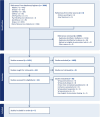Impact of exercise to treat postural orthostatic tachycardia syndrome: a systematic review
- PMID: 40365455
- PMCID: PMC12071195
- DOI: 10.3389/fneur.2025.1567708
Impact of exercise to treat postural orthostatic tachycardia syndrome: a systematic review
Abstract
Background: Postural orthostatic tachycardia syndrome (POTS) is a chronic condition associated with a high symptom burden and decreased quality of life (QOL). Exercise is currently considered to be a first line non-pharmacological treatment for POTS. The purpose of this systematic review was to evaluate the impact of exercise on cardiovascular and patient-centered outcomes in patients with POTS.
Purpose: To evaluate whether exercise benefits patients with POTS by synthesizing data from published clinical studies.
Methods: Electronic databases, including Medline, Embase, CINAHL Complete, Cochrane CENTRAL, and others were searched and results were exported on May 2, 2023. Study inclusion: those that utilized an exercise program as an intervention for POTS and were conducted as experimental or quasi-experimental design. Exclusions: Non-English language papers and opinion-based/theoretical/non-empirical studies/case reports. Data extraction was based on Cochrane Handbook guidance and summarized according to Synthesis Without Meta-analysis (SWiM) guidelines; methodological quality and risk of bias was evaluated using the JBI Critical Appraisal tools. Standardized effects were calculated and summarized based on the direction of effect.
Results: Seven studies included in the final review are described in the data summary and synthesis. Improvements in heart rate were reported across all studies reviewed, while stroke volume and QOL improvements were also found. Notably, not all studies reported on the latter two outcomes. Methodological variability across studies precluded meta-analysis, and risk of bias was considered moderate-high in all but a single study.
Conclusion: While currently available evidence supports exercise as beneficial to QOL and cardiovascular features of POTS, we identified a major need for additional studies assessing the effect of exercise on symptom burden and daily function, including studies that consider patients with specific comorbidities that impact exercise tolerability and/or dosing.
Keywords: POTS; autonomic; exercise rehabilitation program; synthesis; systematic review.
Copyright © 2025 Cortez, Aikins, Arnold, Boris, Davenport, Johnson, Kattaya, Kinsella, McFarland, Pelo, Powers, Schiltz, Stiles, Ziaks, Chung and Dal Molin.
Conflict of interest statement
MMC has received research funding from the National Institutes of Health National Institute of Neurological Disorders and Stroke (K23NS105920 and R61NS125153) and Dysautonomia International (not related to this manuscript). AA serves as a consultant for the Vaccine Injury Compensation Program of the Department of Health and Human Services. JB consults for Argenx, Lumia, and CSL Behring, unrelated to this manuscript. He also serves as a consultant for the US Dept. of Department of Health and Human Services Vaccine Injury Compensation Program. TC received consulting fees from Argenx and Regeneron, and research funding from Dysautonomia International (none related to this manuscript). The remaining authors declare that the research was conducted in the absence of any commercial or financial relationships that could be construed as a potential conflict of interest. The author(s) declared that they were an editorial board member of Frontiers, at the time of submission. This had no impact on the peer review process and the final decision.
Figures



References
-
- Tanking C, Lakkananurak C, Srisakvarakul C, Jitpreeda A, Threechod K, Sukitpunyaroj D. Postural orthostatic tachycardia syndrome and other autonomic dysfunctions following COVID-19: incidence, characteristics, and associated factors. J Arrhythm. (2024) 40:230–6. doi: 10.1002/joa3.13001, PMID: - DOI - PMC - PubMed
-
- Freeman R, Wieling W, Axelrod FB, Benditt DG, Benarroch E, Biaggioni I, et al. . Consensus statement on the definition of orthostatic hypotension, neurally mediated syncope and the postural tachycardia syndrome. Auton Neurosci. (2011) 161:46–8. doi: 10.1016/j.autneu.2011.02.004, PMID: - DOI - PubMed
-
- Sheldon RS, Grubb BP, 2nd, Olshansky B, Shen WK, Calkins H, Brignole M, et al. . 2015 heart rhythm society expert consensus statement on the diagnosis and treatment of postural tachycardia syndrome, inappropriate sinus tachycardia, and vasovagal syncope. Heart Rhythm. (2015) 12:e41–63. doi: 10.1016/j.hrthm.2015.03.029, PMID: - DOI - PMC - PubMed
Publication types
LinkOut - more resources
Full Text Sources

